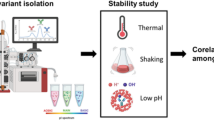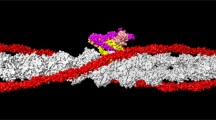Abstract
Proline with its unique geometrical feature generates turn in the peptide backbone. Therefore, aggregation potential of Aβ38 can be modulated by insertion of proline at specific positions. Although site specific proline mutation is reported, effect of multiple proline substitution on aggregation potential is still not demonstrated. Therefore, Aβ38, a single proline substituted variant, V18P-Aβ38, a double proline substituted variant, V18P-I31P-Aβ38 and a triple proline substituted version, V12P-V18P-I31P-Aβ38 were synthesized and their aggregation potential were studied. The proline mutants found to have higher solubility and slower aggregation kinetics. The double mutated version was relatively less aggregation prone than its single mutated version. Such analogues can be useful for designing new β sheet breaker peptides, studying the mechanism of aggregation and structural analyses.








Similar content being viewed by others
References
Camus MS, Santos SD, Chandravarkar A, Mandal B, Schmid AW, Tuchscherer G, Mutter M, Lashuel HA (2008) Switch-peptides: Design and characterization of controllable super amyloid forming host guest peptides as tool for identifying anti amyloid agents. ChemBioChem 9:2104–2112
Chiti F, Dobson CM (2006) Protein misfolding, functional amyloid and human disease. Annu Rev Biochem 75:333–366
Coin I, Beyermann M, Bienert M (2007) Solid-phase peptide synthesis: from standard procedures to the synthesis of difficult sequences. Nat Prot 2(12):3247–3256
Dolphin GT, Dumy P, Garcia J (2006) Control of amyloid β-peptide protofibril formation by a designed template assembly. Angew Chem Int Ed 45(17):2699–2702
Hamley IW, Nutt DR, Brown GD, Miravet JF, Escuder B, Rodriguez-Llansola F (2010) Influence of the solvent on the self assembly of a modified amyloid beta peptide fragment. II. NMR and computer simulation investigation. J Phys Chem B. 114(2):940–951
Hardy J, Selkoe DJ (2002) The amyloid hypothesis of Alzheimer’s disease: progress and problems on the road to therapeutics. Science 297:353–356
Jaroch S (2007) A soluble amyloid fibril segment to study aggregate formation. Chem med chem. 2:47–49
Lazo ND, Grant MA, Condron MC, Rigby AC, Teplow DB (2005) On the nucleation of amyloid β-protein monomer folding. Protein Sci 14(6):1581–1596
Morimoto A, Irie K, Murakami K, Masuda Y, Ohigashi H, Nagao M, Fakuda H, Shimizu T, Shirasawa T (2004) Analysis of the secondary structure of β-amyloid (Aβ42) fibrils by systematic proline replacement. J Biol Chem 279(50):52781–52788
Naldi M, Fiori J, Pistolozzi M, Drake AF, Bertucci C, Wu R, Mlynarczyk K, Filipek S, Simone AD, Andrisano V (2012) Amyloid β-peptide 25-35 self assembly and its inhibition: A model undecapeptide system to gain atomistic and secondary structure details of Alzheimer’s disease and treatment. Acs Chem Neurosci 3(11):952–962
Petkova AT, Ishii Y, Balbach JJ, Antzutkin ON, Leapman RD, Delaglio F, Tycko R (2002) A structural model for Alzheimer’s β-amyloid fibrils based on experimental constraints from solid state NMR. Proc. Nat. Acad. Sci. USA 99(26):16742–16747
Selkoe DJ (2001) Alzheimer’s disease: genes, proteins and therapy. Physiol Rev 81(2):741–766
Soto C, Sigurdsson EM, Morelli L, Kumar RA, Castano EM, Frangione B (1998) β sheet breaker peptides inhibit fibrillogenesis in a rat brain model of amyloidosis: Implications for Alzheimer’s therapy. Nat Med 4(7):822–826
Takahashi T, Mihara H (2008) Peptide and protein mimetics inhibiting amyloid β aggregation. Acc Chem Res 41(10):1309–1318
Tickler AK, Barrow CJ, Wade JD (2001) Improved preparation of amyloid-β peptides using DBU as N α -Fmoc deprotection reagent. J Pep Sci 7(9):488–494
Tycko R (2004) Progress towards a molecular-level structural understanding of amyloid fibrils. Curr Opin Struct Biol 14(1):96–103
Williams AD, Portelius E, Kheterpal I, Guo J, Cook KD, Xu Y, Wetzel R (2004) Mapping Aβ amyloid fibril secondary structure using scanning proline mutagenesis. J Mol Bio 335:833–842
Wood SJ, Wetzel R, Martin JD, Hurle MR (1995) Prolines and amyloidogenecity in fragments of the Alzheimer’s peptide β/A4 Biochemistry 34: 724-730.
Zarandi M, Soos K, Fulop L, Bozso Z, Datki Z, Toth GK, Penke B (2007) Synthesis of Aβ [1-42] and its derivatives with improved efficiency. J Pep Sci 13(2):94–99
Acknowledgements
We are thankful to CIF, IITG for TEM studies, Mr. Sameer Hussain and Prof. P. K. Iyer for their help in birefringence studies, Mr. Mohitosh Dey and Prof. S. S. Ghosh for their help in CD studies, reviewers for constructive suggestions and BRNS DAE (2008/20/37/6/BRNS) for financial support.
Conflict of interest
Nadimpally Krishna Chaitanya, Ashim Paul, Abhijit Saha and Bhubaneswar Mandal declare that they have no conflict of interest. This article does not contain any studies with human or animal subjects.
Author information
Authors and Affiliations
Corresponding author
Rights and permissions
About this article
Cite this article
Chaitanya, N.K., Paul, A., Saha, A. et al. Modulation of Aggregation Propensity of Aβ38 by Site Specific Multiple Proline Substitution. Int J Pept Res Ther 19, 365–371 (2013). https://doi.org/10.1007/s10989-013-9360-1
Accepted:
Published:
Issue Date:
DOI: https://doi.org/10.1007/s10989-013-9360-1




